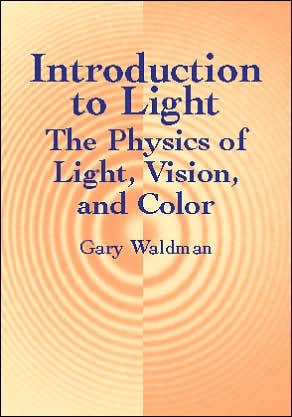

 |

|

Sold Out
Book Categories |
Preface
Part I. What Is Light?
Chapter 1. Early Ideas of Light
1.1 Greek Optics
1.2 Optics in the Middle Ages
1.3 A New Beginning
Chapter 2. The Classical Theories
2.1 The Corpuscular Theory
2.2 The Wave Theory
2.3 Electromagnetic Waves
Chapter 3. Modern Theories
3.1 Blackbody Radiation
3.2 Photoelectric Effect
3.3 The Nuclear Atom
3.4 Matter Waves
Part II. Manipulation of Light
Chapter 4. Geometrical Optics
4.1 Light Rays
4.2 Reflection and Refraction
4.3 Spherical Lenses and Mirrors
4.4 Conic Section Mirrors
Chapter 5. Polarization
5.1 Transverse Waves and Polarization
5.2 Polarization by Reflection
5.3 Polarization by Scattering
5.4 Double Refraction
5.5 Circular Polarization
Chapter 6. Lasers
6.1 Absorption and Emission
6.2 Population Inversion
6.3 Ruby Laser
6.4 Helium-Neon Laser
6.5 Other Laser Types
6.6 Effects of the Optical Cavity
6.7 Coherence
6.8 Applications
Chapter 7. Holography
7.1 Zone Plates
7.2 Hologram as a Set of Zone Plates
7.3 Improved Holograms
7.4 Holography and Photography
7.5 Holograms as Sets of Hyperbolic Mirrors
7.6 New Types of Holograms
7.7 Applications
Part III. Vision
Chapter 8. The Eye
8.1 Outer Shell
8.2 Pupil
8.3 Lens
8.4 Retina
8.5 Pathways to the Brain
Chapter 9. Seeing
9.1 Eye Movements
9.2 Optical Illusions
9.3 Seeing in Three Dimensions
9.4 Color Vision
Part IV. Color
Chapter 10. Light and Color in Nature
10.1 Natural Light
10.2 Forced Oscillators
10.3 Rayleigh Scattering
10.4 White Light Scattering
10.5 Dispersion
10.6 Coronas and the Glory
10.7 Thin Film Colors
10.8 Pigments in Nature
10.9 Other Natural Lighting Effects
Chapter 11. Color Science
11.1 Newton's Work
11.2 Primary Colors
11.3 Attributes of Color
11.4 Color Solid and Color Atlases
11.5 Colorimetry
Appendix A. Lens and Mirror Equations
Appendix B. Snell's Law
Appendix C. Scientific Notation
Index
Login|Complaints|Blog|Games|Digital Media|Souls|Obituary|Contact Us|FAQ
CAN'T FIND WHAT YOU'RE LOOKING FOR? CLICK HERE!!! X
 You must be logged in to add to WishlistX
 This item is in your Wish ListX
 This item is in your CollectionIntroduction to Light: The Physics of Light, Vision, and Color
X
 This Item is in Your InventoryIntroduction to Light: The Physics of Light, Vision, and Color
X
 You must be logged in to review the productsX
 X
 X

Add Introduction to Light: The Physics of Light, Vision, and Color, Designed for a nonmathematical undergraduate optics course addressed to art majors, this four-part treatment discusses the nature and manipulation of light, vision, and color. Questions at the end of each chapter help test comprehension of material, which, Introduction to Light: The Physics of Light, Vision, and Color to the inventory that you are selling on WonderClubX
 X

Add Introduction to Light: The Physics of Light, Vision, and Color, Designed for a nonmathematical undergraduate optics course addressed to art majors, this four-part treatment discusses the nature and manipulation of light, vision, and color. Questions at the end of each chapter help test comprehension of material, which, Introduction to Light: The Physics of Light, Vision, and Color to your collection on WonderClub |